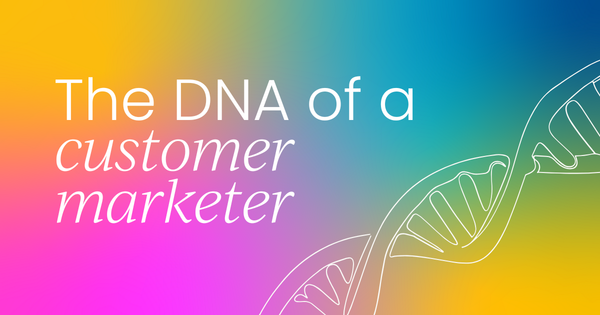What does a customer marketer do?
Customer marketing can be a tough role to define. It looks a little different at every company, and depending on where it sits in the org chart, priorities can vary wildly. It can sometimes be tricky to pin down their "typical" day-to-day activities.
But one thing’s for sure: customer marketers bring serious strategic value. They're the glue between teams, the voice of the customer (VoC) inside the business, and the driving force behind retention, advocacy, and expansion.
So, what makes a customer marketer tick? Let’s break it down.
What makes a customer marketer?
Customer marketers wear a lot of hats, but the best ones share a few key traits.
- Big-picture thinkers: They don’t just deliver campaigns – they tie everything back to company goals, keeping a close eye on ROI and long-term impact.
- Natural collaborators: Customer marketers thrive on teamwork. They connect success, sales, product, and marketing so everyone’s pulling in the same direction.
- Resourceful and flexible: The field is always evolving, and customer marketers adapt fast. They’re creative problem-solvers who find ways forward even when resources are tight.
- Customer fanatics: At their core, they care deeply about creating experiences people love, going above and beyond to make that happen.
When we asked senior customer marketing leaders what they look for when hiring, here’s what they said:
Kalyn New, VP of Product & Customer Marketing at ROLLER, had this to say:
"I look for people who have worked in loyalty or retention before - across any industry. SaaS/subscription experience is also a plus as it means you have that focus on content and value, whether B2B or B2C. They also need to be data-driven."

Key responsibilities of a customer marketer
Customer marketing looks different everywhere, but you’ll usually find marketers in this role doing some or all of the following:
- Setting the tone for customer communications and creating experiences that stand out.
- Managing advocacy programs, onboarding, engagement campaigns, and customer communications.
- Identifying opportunities for cross-sells, upsells, renewals, and referrals.
- Tracking customer metrics and sharing insights with leadership.
- Working closely with other teams to find advocates for testimonials, events, and case studies.
Again, this is by no means exhaustive. Customer marketing activities will often overlap with customer success, sales, and product marketing teams.

Where customer marketing fits in an org
There’s a lot of debate about where customer marketing "belongs."
In some companies, it sits alongside product marketing and customer success, focusing on adoption, retention, and product engagement. In others, it’s part of a broader marketing function with an emphasis on content, advocacy, and lifecycle campaigns.
The truth? Customer marketing’s still defining itself as a discipline. But it’s quickly becoming a core part of growth strategy, not just a nice-to-have.
At our Customer Marketing Summits, leaders consistently agree: customer marketing is evolving into a standalone powerhouse. It’s cross-functional by design and essential for connecting customer success with long-term revenue growth.
Startups are especially leaning in early, using customer marketing to build advocacy from day one. Mature orgs are scaling it fast, as they've wised up to just how much influence it has on renewal rates, brand love, and expansion.
Besides the fact that it has a place within every organization, there seems to be a lot of debate about what exactly a customer marketing function looks like.
Team structures and roles
If you’re leading customer marketing (or you’re a team of one right now), structure matters. Here’s what some common setups look like, and how they complement each other:
Customer Advocacy Manager
If you already have strong retention programs in place, adding an advocacy role can help level up your customer relationships.
They typically own:
- Onboarding advocates and managing reviews or references
- Customer advisory boards (CABs)
- Building and maintaining advocacy and rewards programs
- Voice of the customer (VoC) initiatives
An advocacy manager works closely with community roles to turn happy customers into vocal advocates.
Community Manager
Community managers bring people together – customers, partners, even internal stakeholders – to share, learn, and connect.
They often oversee:
- Events, communications, and social engagement
- Community platforms and spaces
- Gathering and amplifying customer feedback
- Building authentic relationships between customers and your brand
Community management is where connection meets strategy. Done right, it supports retention and advocacy at every level.
Program Director
Think of this role as the strategist. Program directors oversee the bigger picture, ensuring every campaign, touchpoint, and message contributes to the customer lifecycle.
They focus on:
- Identifying strengths and weaknesses in the customer journey
- Segmenting audiences and tailoring experiences
- Developing content and educational programs
- Measuring the business impact of advocacy and engagement efforts
It’s a high-level role, but a vital one for scaling customer marketing in growing organizations.
These roles both span the scope of customer marketing and divide responsibilities efficiently, and are flexible enough to be modified to fit the needs of your brand. Ownership of specific tasks and processes is tricky at the best of times, and you will know best how they might align with your internal structure.

If you’re new to customer marketing, or perhaps are building the function from scratch, it can often feel overwhelming at first. But every great program starts small.
Here’s what seasoned customer marketers recommend focusing on in your first six months:
- Do your homework. Learn how your internal teams work – especially customer success and sales. Understand their goals, challenges, and where customer marketing can help.
- Start with small wins. Don’t aim to overhaul everything at once. Launch a small campaign, improve a single onboarding flow, or test a customer story initiative.
- Be visible and collaborative. Build relationships early. When people see the impact of your work, you’ll gain buy-in fast.
- Learn from the community. Join the Customer Marketing Alliance Slack or connect on LinkedIn – the community’s full of pros sharing playbooks and lessons learned.
Many customer marketers say their first big project was launching or growing a community. It’s a smart move; community naturally fuels engagement, advocacy, and retention.
If you go that route, start with a clear vision:
- What’s your community for?
- Who’s it helping?
- How will it connect back to your brand’s goals?
And don’t forget to loop in your stakeholders. Sales, CS, and product often have great ideas and connections you can build on.
You’ve got the mindset. Now master the method.
Customer Marketing Certified: Core gives you the proven strategies, practical frameworks, and expert insights to build customer programs that inspire loyalty, drive growth, and prove ROI across your organization.
Learn directly from industry pioneers at Google, HubSpot, Venmo, Gong, and more as you master the art of customer-centric marketing.
Get certified, empower your teams, and become the driving force for customer success in your company.


 5 min read
5 min read
 Follow us on LinkedIn
Follow us on LinkedIn



